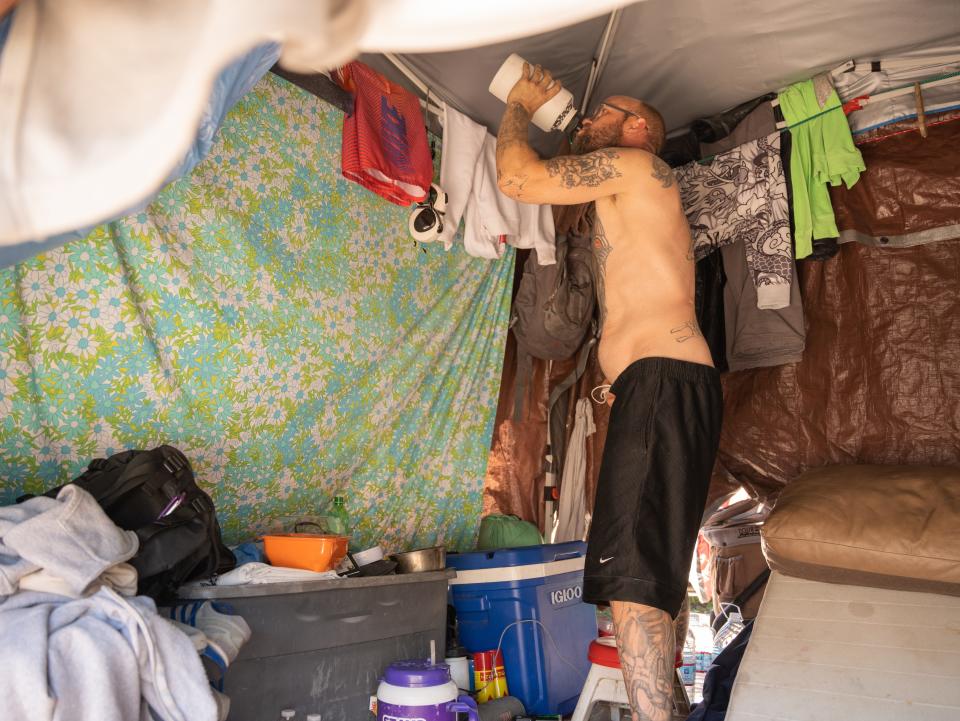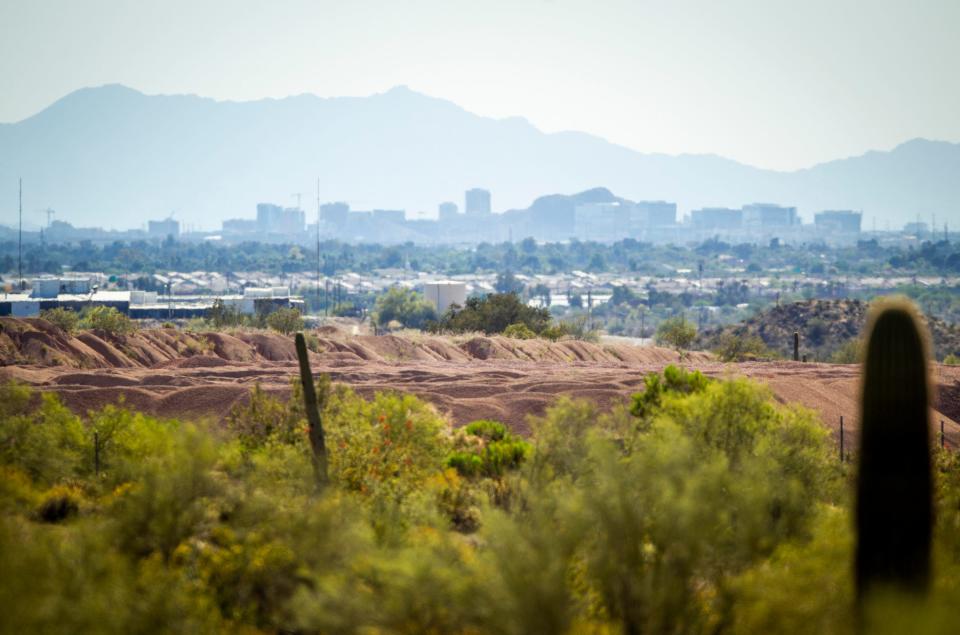Phoenix is not prepared for a simultaneous heat wave and blackout, new research shows
If a five-day heat wave and a blackout power outage hit Phoenix at the same time, nearly 817,000 people — more than 50% of the city's current population of 1.4 million — could end up in the emergency room, a new study has calculated.
By the year 2055, under projected warming scenarios due to climate change, that number would rise to nearly 877,000 people requiring a visit to the ER and to nearly 989,000 by 2085, not accounting for population growth.
That's a big problem for America's hottest big city, which currently has fewer than 3,000 emergency department beds.
What does the data say?
The study, published Tuesday in the scientific journal Environmental Science & Technology, also evaluated the potential human health impact of a blackout during a five-day heat wave in Atlanta and Detroit. But the toll in Phoenix dwarfs that in both of those cities.
That's because extreme temperatures in Phoenix are more extreme than in most other U.S. cities and because 90% of Phoenix residents rely on air conditioning units that would not function during a blackout. While scientists defined a heat wave in Detroit, where only 60% of residents have air conditioning, as a five-day period when temperatures range between 72 and 95 degrees Fahrenheit, a heat wave in Phoenix is defined as a five-day period with temperatures that stay between 90 and 113 degrees.
More: Exertional heat stroke is on the rise for athletes. Could tracking urine be the answer?
The frequency of both heat waves and major electrical grid failures has increased dramatically in recent years. Since 2015, when the U.S. Energy Information Administration started reporting monthly on blackouts, the number of such events affecting more than 50,000 people and lasting longer than one hour has doubled, from around 45 in 2015 to 90 in 2021.
Matei Georgescu, a professor at Arizona State University and the paper's senior author, said the odds of a five-day heat wave occurring during a major power outage are small. But it's happened before, for example in the northeast U.S. in August 2003. It's important to predict the impact of such events so that cities can better prepare.
“Low likelihood events, even if some mathematician rounds them off to zero, still happen and have happened in reality," Georgescu said. "And if we don’t account for these, we’re in trouble.”
Phoenix's unhoused population at risk during potential heat wave
The scientists also calculated likely mortality rates in each of these cities during a five-day heat wave without power. As with the emergency room visits calculation, they used a complicated model that estimated individual exposure over time to specific temperatures common in certain environments, whether indoors, outdoors or in a vehicle, for different people based on where they live and typical daily movement patterns.
They found that around 1% of the Phoenix population would succumb to such an event, amounting to a death toll of about 13,250 people, 10 times the number of fatalities that resulted from Hurricane Katrina in 2005. Elderly residents, children, those living in lower-income neighborhoods that can be 10 degrees hotter than wealthier ones and those with pre-existing health conditions would likely make up a large percentage of this total, as these groups are more vulnerable to the health effects of extreme heat.

Proof that the study's numbers are in the right ballpark has been borne out in Phoenix by heat deaths among the unhoused population, who regularly experience the type of exposure conditions without air conditioning that the paper simulates. In 2021, the Maricopa County Public Health Department reported 130 heat-related deaths among an estimated local homeless population of 8,200. (Recent reporting by The Republic suggests this total is an underestimate.)
This equates to a mortality rate of 1.6% among the unhoused population during a heat wave, a number that falls between the scientists' estimated death toll of 0.9% of overall residents in current conditions and 1.9% under increased temperatures in 2085. The study did not account for the ability of people to leave town to seek relief, but many vulnerable residents might not have that option.
What are the potential solutions?
"The results from this study emphasize why it is so important to invest in short-term emergency response measures for managing heat events and longer-term strategies that can cool the city," David Hondula, an author on the study and the head of Phoenix's Office of Heat Response and Mitigation, told The Republic. "The comprehensive approach that Phoenix is adopting is helping us become more resilient not just to the routine heat that we can expect every summer, but also to low-probability, high-impact scenarios like a multi-day regional outage."
Read our climate series: The latest from Joan Meiners at azcentral, a column on climate change that publishes weekly
Solutions the scientists considered included increasing tree shade along major roadways to 50% and expanding the use of cool roof coatings to reduce urban temperatures. They calculated that these interventions could potentially save around 250 to 600 lives, respectively, per 100,000 Phoenix residents if fully implemented. Data on the current percentage of roadway shading by trees in Phoenix is not available, the study reported.
Given the ongoing drought, water crisis and shortages on the Colorado River, vastly expanding tree planting throughout Phoenix may not immediately seem like a plausible solution. But Georgescu asserted to The Republic that, if irrigation practices included better water conserving measures like drip irrigation and only watering at night, the water supply could stretch to accommodate many extra trees.

Another intervention frequently hailed as a solution to extreme heat in Phoenix are cooling centers. These are facilities and businesses that have signed up with the city's "Heat Relief Network," managed by Hondula, to allow residents who may not have air conditioning at home to come inside and cool off. A study published last year and reported in The Republic found that these centers are unlikely to make a major dent in heat deaths since they are underused and many residents don't know about them or how to get there. Still, Phoenix has plans to expand the network to deal with impacts of extreme heat, particularly among the unhoused community.
How Phoenix is trying to cool itself: Amid heat waves, a study questions cooling centers. A Phoenix official says we need more
Cooling centers are also limited in that if a major blackout struck Phoenix centers without backup power would have little to offer residents seeking escape from their warming homes. And the problem of the heat relief network not being well known would be compounded once the ability to charge phones and communicate went out.
“There’s a social aspect. If something like this were to happen, how does one get the word out about cooling centers and hydration stations when nobody has energy anymore?" Georgescu said. "We didn’t touch on this in the study but I think that would interesting due to the broader implications."
An intervention not included in the study, but one that Georgescu says he is working on separately, is the ability of the solar grid and battery storage to provide emergency energy in the event of a power failure. He said the expansion of solar infrastructure provides opportunities not only for additional sources of power that may be safer from certain outages, but that the panels themselves can offer shade if installed within urban areas.
Floris Wardenaar, a professor at ASU who studies the effects of extreme heat on human health, said it's important to be aware of the signs of heat exhaustion — which include dizziness, excessive sweating, cool, pale, and clammy skin, nausea or vomiting, rapid, weak pulse and muscle cramps — and the more serious heat stroke, which can be evidenced by a throbbing headache, no sweating, red, hot, dry skin, nausea or vomiting, a rapid, strong pulse and a possible loss of consciousness. Spending time in a swimming pool, if one is available, or wetting clothing can help, he said.
"(This paper) is very important, as power outages do happen," Wardenaar said. "I remember the one in Texas a couple of winters ago. Especially because Phoenix is heavily AC-reliant, a backup plan is needed. This research will help to make people aware that our cities and county should invest in greener streets and roofs, as modeled in the paper."
Joan Meiners is the climate news and storytelling reporter at The Arizona Republic and azcentral.com. Before becoming a journalist, she completed a doctorate in ecology. Follow Joan on Twitter at @beecycles or email her at joan.meiners@arizonarepublic.com. Read more of her coverage at environment.azcentral.com.
Support climate coverage and local journalism by subscribing to azcentral.com at this link.
This article originally appeared on Arizona Republic: Phoenix is not prepared for a simultaneous heat wave and blackout

